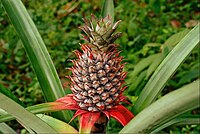
Photo from wikipedia
In the past few years, the global demand in bioethanol has been continuously rising due to its economic importance. Several countries have exerted considerable efforts in the production of bioethanol… Click to show full abstract
In the past few years, the global demand in bioethanol has been continuously rising due to its economic importance. Several countries have exerted considerable efforts in the production of bioethanol as a transport fuel from different feedstocks and started to practice consuming this environment-friendly fuel. Thailand is now one of the top consumers of bioethanol in South East Asia and belongs to the top 5 leading countries in producing pineapples. Production of bioethanol from pineapple wastes, especially the fruit peels, became possible. In this study, the effects of alkaline pretreatment and microbial hydrolysis through Trichoderma harzianum of pineapple fruit peel were evaluated. Among the four concentrations of NaOH, the 0% NaOH gave the highest total and reducing sugar (458.44 ± 13.6 g/L and 279.67 ± 21 g/L) than 1%, 3%, and 5% concentrations of NaOH. Samples pretreated with 0% NaOH were subjected to microbial hydrolysis which showed an increase in reducing sugar of the samples. At the end of the experiment, a bioethanol yield of 5.98 ± 1.01 g/L from pineapple fruit peel was successfully produced at 48 h of fermentation.
Journal Title: Biomass Conversion and Biorefinery
Year Published: 2019
Link to full text (if available)
Share on Social Media: Sign Up to like & get
recommendations!